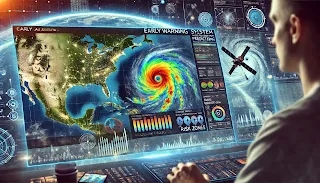How AI is Revolutionizing Disaster Management: A Lifesaving Technology
- Get link
- X
- Other Apps
How AI is Revolutionizing Disaster Management: A Lifesaving Technology
Introduction
Disasters—whether natural or man-made—can strike at any moment, causing widespread devastation. Effective disaster management is crucial to minimizing damage, saving lives, and rebuilding affected areas. In recent years, Artificial Intelligence (AI) has emerged as a game-changer in this field, offering advanced solutions for prediction, preparedness, response, and recovery.
From predicting hurricanes and earthquakes to coordinating emergency responses, AI-driven technologies are transforming the way we handle crises. This article explores how AI is revolutionizing disaster management, its key benefits, challenges, and what the future holds for AI-powered disaster response.
1. How AI is Used in Disaster Management
AI enhances disaster management in four key phases: prediction, preparedness, response, and recovery.
 |
1.1 Predicting Disasters with AI
AI helps identify potential disasters before they occur, giving authorities valuable time to take action.
- Earthquake forecasting: AI detects subtle seismic activity patterns that could indicate an upcoming earthquake.
- Flood prediction: AI analyzes real-time weather conditions, river levels, and topography to predict floods.
- Hurricane tracking: AI-powered models improve the accuracy of hurricane path predictions, helping communities prepare.
- Wildfire detection: AI analyzes satellite imagery and environmental data to detect early signs of wildfires.
✅ Example: NASA uses AI-driven satellite imaging to track hurricanes and predict their potential impact.
1.2 AI in Disaster Preparedness
AI early warning system, disaster prediction with artificial intelligence, AI forecasting natural disasters

AI early warning system, disaster prediction with artificial intelligence, AI forecasting natural disasters
AI assists in planning and risk assessment, making preparedness more effective.
- Evacuation route planning: AI identifies the safest and fastest escape routes based on traffic patterns and road conditions.
- Supply chain management: AI predicts where food, water, and medical supplies will be needed most.
- Infrastructure risk analysis: AI assesses the vulnerability of buildings, bridges, and power grids to disaster damage.
✅ Example: The Red Cross uses AI to predict areas that will need the most aid before a disaster hits.
1.3 AI in Disaster Response
AI search and rescue, artificial intelligence in disaster response, AI-powered rescue drones

AI search and rescue, artificial intelligence in disaster response, AI-powered rescue drones
AI speeds up real-time decision-making and coordination during a disaster.
- Drones & AI-powered imaging: Drones equipped with AI assess damage, locate survivors, and deliver emergency supplies.
- Social media analysis: AI scans social media for SOS messages, helping rescue teams prioritize areas in need.
- AI-powered chatbots: Automated chatbots provide real-time updates to affected communities.
✅ Example: During Hurricane Harvey, AI analyzed social media posts to identify stranded victims and direct rescue teams.
1.4 AI in Disaster Recovery
Post-disaster, AI helps with rebuilding and recovery efforts.
- Damage assessment: AI uses satellite images and drone footage to analyze destruction and prioritize rebuilding.
- Resource allocation: AI predicts which communities need the most aid and distributes resources accordingly.
- Mental health support: AI-driven chatbots provide psychological support to disaster survivors.
✅ Example: AI helped Puerto Rico assess damages after Hurricane Maria, streamlining recovery efforts.
2. Benefits of AI in Disaster Management
The integration of AI into disaster management provides several advantages:
2.1 Faster and More Accurate Predictions
AI can process vast amounts of data quickly, providing more accurate disaster forecasts than traditional methods.
2.2 Smarter Resource Allocation
AI ensures that emergency resources (food, water, medical supplies) are delivered where they are needed most, preventing waste and shortages.
2.3 Improved Decision-Making
AI provides real-time insights to emergency responders, helping them make better decisions under extreme pressure.
2.4 Reduced Human Risk
AI-powered robots and drones can enter dangerous areas, reducing risks for human rescuers.
3. Challenges of Using AI in Disaster Management
Despite its advantages, AI faces several challenges in disaster management.
3.1 Data Quality and Availability
AI relies on large amounts of accurate data, but in many regions, real-time data collection is limited.
3.2 Ethical and Privacy Concerns
Using AI for surveillance and disaster tracking raises privacy concerns, especially when personal data is involved.
3.3 Dependence on Infrastructure
AI systems require powerful computing and internet access, which may be unavailable during disasters.
✅ Solution: Investing in offline AI solutions and better data-sharing practices can help overcome these challenges.
4. Real-World Examples of AI in Disaster Management
AI has already proven its value in real disaster situations:
4.1 AI in Earthquake Prediction
- Scientists are using AI to detect small seismic shifts, giving early warnings before major earthquakes.
4.2 AI for Flood Forecasting
- Google’s Flood Hub uses AI to predict floods in over 80 countries, helping authorities take preventive action.
4.3 AI-Powered Wildfire Detection
- AI models analyze satellite imagery to detect wildfires before they spread, enabling faster firefighting responses.
✅ Example: AI helped firefighters predict and control California’s wildfires, reducing damage and saving lives.
5. The Future of AI in Disaster Management
AI’s role in disaster management will continue to expand with new technological advancements.
5.1 AI and IoT (Internet of Things) Integration
- Smart sensors will monitor real-time environmental changes (e.g., temperature, air pressure, seismic activity).
5.2 AI-Powered Robots for Search and Rescue
- Advanced AI-driven robots will navigate collapsed buildings and rescue trapped victims.
5.3 Predictive AI for Climate Change Disasters
- AI will help governments anticipate and prepare for disasters caused by climate change, such as rising sea levels.
✅ Future Goal: AI-driven systems will provide faster, more effective disaster response worldwide.
Conclusion
AI is revolutionizing disaster management, making predictions more accurate, responses faster, and recovery more efficient. By integrating AI into disaster response strategies, governments and relief organizations can save more lives, minimize destruction, and rebuild communities faster.
However, for AI to reach its full potential, data sharing, ethical considerations, and infrastructure improvements must be addressed. With continued advancements, AI will become an essential tool in global disaster management, helping us create a safer and more resilient future.
- Get link
- X
- Other Apps




Comments
Post a Comment